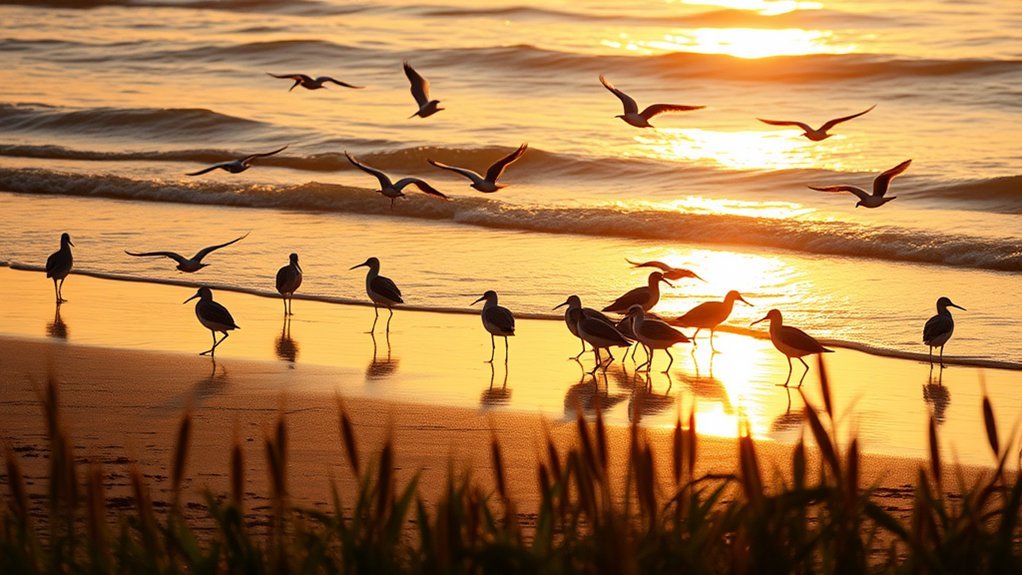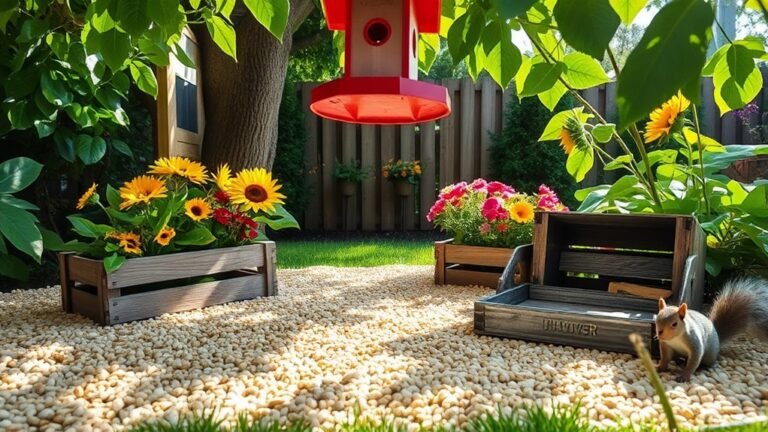Shore Birds in South Carolina: Coastal Dwellers
Shore birds in South Carolina are important for the coastal ecosystem. Species like the Black Skimmer and Snowy Plover thrive on sandy beaches. Their foraging and nesting behaviors show how they adapt to their environment. However, these birds face challenges such as habitat loss and climate change. Understanding these issues is crucial. It highlights the balance of our coastal regions and the risks we face if we ignore their needs. Protecting shore birds is essential for maintaining a healthy coastal environment, benefiting both these birds and the ecosystems they inhabit.
Key Takeaways
South Carolina's coast hosts various shore bird species, including the Black Skimmer, Royal Tern, and Snowy Plover. These birds use different foraging methods to catch crustaceans and mollusks. These prey items are vital for a healthy coastal ecosystem.
Many shore birds choose sandy habitats for nesting to reduce disturbances. Unfortunately, climate change and habitat destruction pose significant threats to these bird populations. This situation emphasizes the importance of conservation efforts.
Community involvement in local conservation initiatives is essential to protect these shore birds and their habitats. Together, we can help ensure a safe environment for these coastal dwellers.
Overview of South Carolina's Shore Birds

South Carolina's shorelines are vital habitats for various shore birds. These birds play important roles in the local ecosystem. Many species depend on these coastal areas for nesting and feeding. They adapt to the unique coastal conditions.
Migratory patterns greatly impact their populations. Many shore birds travel thousands of miles each year to find seasonal food. These movements relate closely to environmental factors like tides and weather.
By observing these patterns, we can understand their behaviors and the overall health of the ecosystem.
Protecting these habitats ensures the survival of these amazing birds. Engaging with these environments enriches our connection to nature and underscores the need for their conservation.
Key Species of Shore Birds
South Carolina's shorelines support several key bird species that highlight the area's avian diversity.
Learning about these birds enhances our understanding of their migration patterns and habitat needs. Here are four important species:
- Black Skimmer: This bird has a unique bill and prefers sandy shores. It typically feeds at sunrise and sunset.
- Royal Tern: Common along the coast, this bird travels long distances during migration and nests on the beach.
- Snowy Plover: A small and elusive bird, the Snowy Plover breeds in open sandy areas and is well suited to its habitat.
- Willet: This large shorebird is often found in estuaries and tidal flats, particularly during migration.
Each of these species plays a vital role in South Carolina's coastal ecosystem.
Understanding them helps foster appreciation for the region's natural beauty.
Feeding Habits and Diet

The feeding habits and diet of shore birds in South Carolina provide valuable insights into their roles in the ecosystem.
These birds use different foraging techniques like probing, pecking, and sweeping. They feed on various food sources, including crustaceans and mollusks.
Their ability to adapt their diet helps them respond to changes in food availability, especially during migration. For example, migratory shore birds often go to nutrient-rich estuaries to prepare for their long flights.
Observing how these birds feed shows their adaptability and importance in keeping coastal ecosystems healthy by controlling prey populations.
Understanding their dietary habits connects us to the diverse life along South Carolina's shores.
Breeding and Nesting Behaviors
Coastal habitats are crucial for shore birds in South Carolina. These birds show interesting nesting behaviors that help them adapt to their environment. During courtship, males display their feathers and call out to attract females.
Choosing the right nesting spot is important; many birds prefer sandy beaches and dunes that have low human activity.
Here are some key nesting behaviors:
- Site Selection: Birds claim areas with little human disturbance.
- Scrape Nests: Some species make simple depressions in the sand instead of building complex nests.
- Egg Camouflage: Their eggs are often speckled, helping them blend in with the surroundings.
- Parental Investment: Both parents take turns incubating the eggs, which helps increase chick survival.
These behaviors show how shore birds connect with their environment and adapt for survival.
Threats to Shore Bird Populations

Shore bird populations in South Carolina are in danger due to several threats. Habitat destruction, caused by coastal development and urbanization, reduces the natural areas these birds need for nesting and finding food.
If you walk along the shorelines, you may spot displaced nests and fewer food sources, indicating a serious issue.
Climate change adds to these problems. Rising sea levels and unpredictable weather threaten shore bird habitats. Increased storms can wash away nests, and changing temperatures can disrupt migration patterns.
It is important to recognize these factors. They show us the urgent need to protect these vulnerable birds.
Conservation Efforts and Importance
To protect shorebirds in South Carolina, we need to take action together. These birds rely on healthy habitats for nesting and feeding.
Here are key steps you can follow to help:
- Join local cleanup events to keep bird habitats clean.
- Report any shorebird sightings to aid research efforts.
- Volunteer with groups that restore habitats for wildlife.
- Support laws that protect these birds and their environments.
Your involvement is critical. By working together, we can strengthen our community connections to nature.
Together, we can help ensure the survival of shorebirds and support healthier coastal ecosystems for everyone.
Frequently Asked Questions
What Is the Best Time of Year to Observe Shore Birds in South Carolina?
To observe shore birds in South Carolina, plan your visit during their migration periods in spring and fall. During these times, you can see many different species along the coast. This experience will help you connect more with nature. Enjoy the sights and sounds of these remarkable birds as they move to their seasonal habitats.
How Can I Identify Different Species of Shore Birds?
To identify different species of shore birds, focus on key features such as size, color patterns, and behavior. Pay attention to where each species prefers to live and note their calls. Observing these details will improve your birdwatching skills and provide a closer connection to nature. Enjoy the process of discovering these fascinating birds!
Are There Any Guided Tours for Shore Bird Watching in South Carolina?
Yes, South Carolina offers several guided shore bird watching tours. Local guides organize trips to help you see various bird species. They share their knowledge about the birds and the coastal environment. This makes your experience enjoyable and informative.
What Equipment Do I Need for Shore Bird Photography?
For shore bird photography, you need a telephoto lens. This helps you capture birds from a distance. Use fast shutter speeds to freeze motion and adjust aperture for depth in your images. Increase ISO for better performance in low light. These settings will help you take sharp and clear photos. Enjoy your photography!
Can Shore Birds Be Seen Inland or Only Along the Coast?
Shore birds are usually found along the coast. However, some shore birds do travel inland during migration. They can be spotted at temporary habitats like lakes and wetlands. This shows how they can adapt to environments beyond the coast. Observing these birds in various settings adds to their appeal for nature enthusiasts.

Ava is a bird enthusiast and nature lover who has spent countless hours observing and learning about the fascinating world of birds. With a passion for sharing her knowledge and inspiring others to appreciate the beauty of birds, Ava writes about her experiences and insights on avianadmirer.com.







